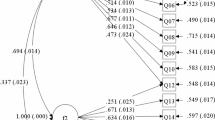Abstract
Little research has examined the properties of survey instruments when the full instrument is not administered (scale carving). The purpose of the present study was to test scale carving effects on survey instruments. Participants completed carved and whole versions of two instruments measuring violent behaviors and attitudes at two sessions. Findings indicated that administering select subscales rather than the entire instrument affects psychometric properties of certain instruments. For instance, mean scores of certain instruments differed depending upon whether the instruments were administered in their entirety or in carved versions. Reliability coefficients did not differ between carved and whole versions, and correlation coefficients were moderate. Therefore, psychometric properties of carved instruments should be assessed prior to their use in research.
Similar content being viewed by others
References
Ammerman, R. T., and Hersen, M. (1992). Current issues in the assessment of family violence. In Ammerman, R. T., and Hersen, M. (eds.), Assessment of family violence: A clinical and legal sourcebook (pp. 3–10). Wiley, New York.
Barling, J., O’Leary, K. D., Jouriles, E. N., Vivian, D., and MacEwen, K. E., (1987). Factor similarity of the CTS across samples, spouses, and sites. J. Fam. Violence 2: 37–54.
Bruning, J. L., and Kintz, B. L. (1977). Computational handbook of statistics. Scott, Foresman, and Company, Glenview, IL.
Burt, M. R. (1980). Cultural myths and supports for rape. J. Pers. Soc. Psychol. 38: 217–230.
Buss, A. H., and Perry, M. (1992). The aggression questionnaire. J. Pers. Soc. Psychol. 63: 452–459.
Cantos, A. L., Neidig, P. H., and O’Leary, K. D. (1994). Injuries of women and men in a treatment program for domestic violence. J. Fam. Violence 9: 113–124.
DeVellis, R. F. (1991). Scale development: Theory and applications. Sage, Newbury Park, CA.
Dillman, D. A. (1978). Mail and telephone surveys: The total design method. John Wiley and Sons, New York.
Hamilton, J. C., and Shuminsky, T. R. (1990). Self-awareness mediates the relationship between serial position and item reliability. J. Personal. Soc. Psychol. 59: 1301–1307.
Harrison, D. A., and McLaughlin, M. E. (1993). Cognitive processes in self-report responses: Tests of item context effects in work attitude measures. J. Appl. Psychol. 78: 129–140.
Harrison, D. A., McLaughlin, M. E., and Coalter, T. M. (1996). Context, cognition, and common method variance: Psychometric and verbal protocol evidence. Organ. Behav. Hum. Deci. Process. 68: 246–261.
Jackson, D. N. (1970). A sequential system for personality scale development. In Spielberger, C. D. (Ed.), Current topics in clinical and community psychology, (Vol. II) Academic Press, New York, pp. 61–96.
Knowles, E. S. (1988). Item context effects on personality scales: Measuring changes the measure. J. Personal. Soc. Psychol. 55: 312–320.
Loevinger, J. (1957). Objective tests as instruments of psychological theory. Psychological Reports 3: Monograph Supplement 9.
MacKay, N. J., and Covell, K. (1997). The impact of women in advertisements on attitudes toward women. Sex Roles 36: 573–583.
Newmark, L., Harrell, A., and Salem, P. (1995). Domestic violence and empowerment in custody and visitation cases. Fam. Conciliation Courts Rev. 33: 30–62.
Rodenburg, F. A., and Fantuzzo, J. W. (1993). The measure of wife abuse: Steps toward the development of a comprehensive assessment technique. J. Fam. Violence 8: 203–228.
Rosenthal, R. (1984). Meta-analytic procedures for social research. Sage, Beverly Hills, CA.
Schwarz, N. (1999). Self-reports: How the questions shape the answers. Am. Psychol. 54: 93–105.
Shepard, M. F., and Campbell, J. A. (1992). The abusive behavior inventory: A measure of psychological and physical abuse. J. Interpers. Violence 7: 291–305.
St. Lawrence, J. S., and Joyner, D. J. (1991). The effects of sexually violent rock music on males’ acceptance of violence against women. Psychol. Women Q. 15: 49–63.
Steinberg, L. (1994). Context and serial-order effects in personality measurement: Limits on the generality of measuring changes the measure. Journal of Personal. Soc. Psychol. 66: 341–349.
Straus, M. A. (1979). Measuring intrafamily conflict and violence: The Conflict Tactics (CT) Scales. J. Marriage Fam. 12: 75–88.
Straus, M. A., Hamby, S. L., Boney-McCoy, S., and Sugarman, D. B. (1996). Therevised Conflict Tactics Scales (CTS2). J. Fam. Issues 17: 283–316.
Author information
Authors and Affiliations
Corresponding author
Rights and permissions
About this article
Cite this article
Desai, S., Braitman, K.A. The Effects of Scale Carving on Instruments Assessing Violence. J Fam Viol 20, 101–107 (2005). https://doi.org/10.1007/s10896-005-3173-8
Issue Date:
DOI: https://doi.org/10.1007/s10896-005-3173-8




